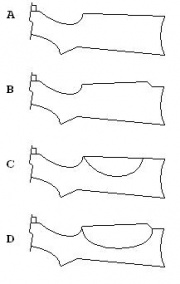Stock
A stock, also known as a buttstock or shoulder stock, is present in many firearms and some crossbows (though a crossbow stock is properly a tiller).[1] The stock provides a means for the shooter to firmly support the device and easily aim it. The stock also transmits recoil into the shooter's body.[2]
Contents[hide] |
History and etymology
The term stock in reference to firearms dates to 1571 is derived from the Germanic word stoc, meaning tree trunk, referring to the wooden nature of the gunstock.[3]
Early hand cannons used a simple stick fitted into a socket in the breech end to provide a handle. The modern gunstock shape began to evolve with the introduction of the arquebus, a matchlock with a longer barrel and an actual lock mechanism, unlike the hand-applied match of the hand cannon. Firing a hand cannon requires careful application of the match while simultaneously aiming; the use of a matchlock handles the application of the slow match, freeing up a hand for support. With both hands available to aim, the arquebus could be braced with the shoulder, giving rise to the basic gunstock shape that has survived for over 500 years.[4] This greatly improved the accuracy of the arquebus, to a level that would not be surpassed until the advent of rifled barrels.
Anatomy of a gunstock
A gunstock is broadly divided into two parts (see above). The rear portion is the butt (1) and front portion is the fore-end (2). The butt is further divided into the comb (3), heel (4), toe (5), and grip (6). The stock pictured is a thumbhole (7) style.[5]
Styles and features of stocks
The most basic breakdown of stock types is into one-piece and two piece stocks. A one piece stock is a single unit from butt to fore-end, such as that commonly found on bolt action rifles. Two piece stocks use a separate piece for the butt and fore-end, such as that commonly found on break open shotguns. Traditionally, two piece stocks were easier to make, since finding a wood blank suitable for a long one piece stock is harder than finding short blanks for a two piece stock.[5]
The grip area is one that varies widely. A straight grip stock (A) proceeds smoothly from toe to the trigger, giving a nearly horizontal angle for the trigger hand, while a full pistol grip stock (E) contains a separate piece for the grip, providing a near vertical angle for the trigger hand, and is commonly found on modern military rifles, such as the ubiquitous AK-47 family of assault rifles. The semi-pistol grip (B) stock is perhaps the most common sporting stock, with a steeper angle cut into the stock to provide a more diagonal angle for the trigger hand. Modern target style stocks have moved towards a fuller, more vertical pistol grip, though built into the stock rather than made as a separate piece, and may be considered pistol grip stocks. Anschütz stocks (C), for example, use a nearly vertical grip, and many thumbhole style stocks (D) are similar to full pistol grips in shape.
The comb is another area of wide variation. Since the comb must support the shooter's cheek at a height suitable for use with the sights, high sights such as telescopic sights require higher combs. The Monte Carlo comb (B) is commonly found on stocks designed for use with scopes, and features an elevated comb to lift the cheek higher, while keeping the heel of the stock low. A cheekpiece (C) is a raised section on the side of the stock, which provides support for the shooter's cheek. There is some confusion between these terms, as the features are often combined, with the raised rollover cheekpiece (D) extending to the top of the stock to form a high Monte Carlo comb.[6][7][5]
Fore-ends tend to vary both in thickness, from the splinter fore-ends common on British side-by-side shotguns to the wide, flat bottomed beavertail fore-ends found on benchrest shooting guns, and in length, from the short AK-47 style to the long Mannlicher stock that runs all the way to the muzzle. Most common on sporting firearms is the half-stock, which extends roughly half the length of the barrel.[5][8]
Stock measurements
Stock measurement is especially important with shotguns, where the typical front-bead-only sight requires a consistent positioning of the shooter's eye over the center of the barrel for good accuracy. When having a stock custom built or bent to fit, there are a number of measurements that are important.[9][5]
- Length of pull, the length measured from the butt of the stock to the trigger
- Drop at heel, the distance from the line of sight to the heel of the butt
- Drop at comb, the distance from the line of sight to the comb
- Cast off, the distance from the center of the butt to the center of the barrel, to the right side as seen from the rear
- Cast on, the distance from the center of the butt to the center of the barrel, to the left side as seen from the rear
- Pitch, the angle of the butt of the stock, determined by a line from heel to toe.
Accuracy considerations
- Main article: Accurizing
In addition to ergonomic issues, the stock can also have a significant impact on the accuracy of the rifle. The key factors are:
- A secure fit between the stock and action, so that the rifle does not shift under recoil
- A stable material, that does not suffer from changes in shape with temperature, humidity, or other environmental conditions to a degree that could adversely impact accuracy
A well designed and well built wooden stock can provide the secure, stable base needed for an accurate rifle, but the properties of wood make it more difficult than more stable synthetic materials. Wood is still a top choice for aesthetic reasons, however, and solutions such as bedding provide the stability of a synthetic with the aesthetics of wood.
Construction
Traditionally, stocks are made from wood, generally a durable hardwood such as walnut. Wood is, however, a poor choice from a functional standpoint, as it tends to absorb water and change its shape, and this can cause serious issues with accuracy. Modern stocks are made from more stable materials, such as thermoplastics and composite materials, such as fiberglass, kevlar, and carbon fiber composites. A growing option is the laminated wood stock, consisting of many thin layers of wood bonded together at high pressures with epoxy, resulting in a dense, stable composite.
Folding, collapsible, or removable stocks tend to be made from a mix of steel or alloy for strength and locking mechanisms, and wood or plastics for shape. Stocks for bullpup rifles must take into account the dimensions of the rifle's action, as well as ergonomic issues such as ejection.
Wood stocks
While walnut is the favored gunstock wood, many other woods are used, including maple, myrtle, birch, and mesquite. Due to the natural properties and variability in woods, stocks made from solid wood must take into account these properties. The grain of the wood determines the strength, and the grain should flow throgh the wrist of the stock and out the toe; having the grain perpendicular to these areas weakens the stock considerably.
In addition to the type of wood, how it is treated can have a significant impact on its properties. Wood for gunstocks should be slowly dried, to prevent grain collapse and splitting, and also to preserve the natural color of the wood; custom stockmakers will buy blanks that have been aged two to three years (enough time to develop color and figure, and past the danger of splitting) and then dry it for several additional years before working it into a stock. Careful selection can yield distinctive and attractive features, such as crotch figure, feathering, fiddleback, and burl, which can significantly add to the desirability of a stock. While a basic, straight grained blank suitable for a utilitarian stock might sell for US$20, an exhibition grade blank with superb figure could fetch in the range of US$2000. Blanks for one piece stocks are more expensive than blanks for two piece stocks, due to the greater difficulty in finding the longer blanks with desirable figure. Two piece stocks are ideally made from a single blank, so that the wood in both parts shows similar color and figure.
Injection molded synthetic
While setup costs are high, once ready to produce, injection molding produces stocks for less than the cost of the cheapest wood stocks. Every stock is virtually identical in dimension, and requires no bedding, inletting, or finishing. The downsides are a lack of rigidity and thermal stability, which are side effects of the thermoplastic materials used for injection molding.
Hand-laid composite stocks
A hand laid composite stock, out of materials such as fiberglass, kevlar, and/or graphite cloth, saturated in an appropriate binder, into a mold. The resulting stock is stronger and more stable than an injection molded stock. It can also be as little as half the weight of an injection molded stock. Inletting and bedding can be accomplished by molding in as part of the manufacturing proceess, machining in the inletting after the stock is finished, molding directly to the action as a separate process, or through the use of a machined metal component molded in place during manufacture. Finish is provided by a layer of gel coat applied to the mold before the cloth is laid up.
Laminated wood
Laminated wood consists of two or more layers of wood, impregnated with glue and attached permanently to each other. The combination of the two pieces of wood, if laid out correctly, results in the separate pieces moderating the effects of changes in temperature and humidity. Modern laminates consist of 1/16 inch (1.6 mm) thick sheets of wood, usually birch, which are impregnated with epoxy, laid with alternating grain directions, and cured at high temperatures and pressures. The resulting composite material is far stronger than the original wood, free from internal defects, and nearly immune to warping from heat or moisture. Typically, each layer of the laminate is dyed before laminating, often with alternating colors, which provides a pattern similar to wood grain when cut into shape, and with bright, contrasting colors, the results can be very striking. The disadvantage of laminate stocks is that the density, with laminates weighing about 4 to 5 ounces (110 to 140 g) more than walnut for a typical stock.
While wood laminates have been available for many years on the custom market (and, in subdued form, in some military rifles), in 1987 Rutland Plywood, a maker of wood laminates, convinced Sturm, Ruger, Savage Arms, and U.S. Repeating Arms Company (Winchester) to display some laminate stocks on their rifles in a green, brown and black pattern (often called camo). The response was overwhelming, and that marked the beginning of laminated stocks on production rifles.
Legal issues
In some jurisdictions, the nature of the stock may impact the legal status of the firearm. Examples of this are:
- Adding a shoulder stock on a firearm with a barrel shorter than 16 inches (40.6 cm) makes it a short barreled rifle under the US National Firearms Act
- Folding stocks or stocks with separate pistol grips are qualifying features in the Federal Assault Weapons Ban, and in some state and local legislation modeled thereafter
Gallery
SIG 550 rifle with folding stock
AK-47, with the two piece pistol grip stock commonly found on military assault rifles





